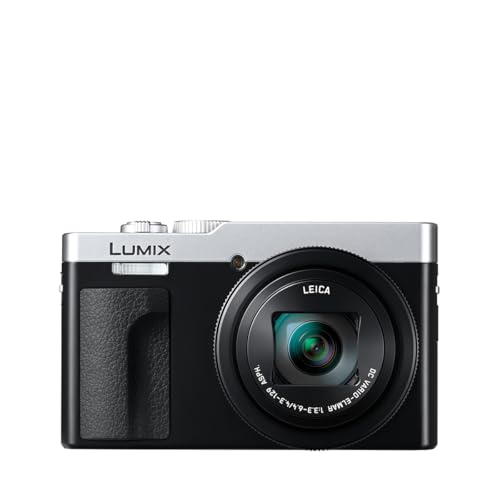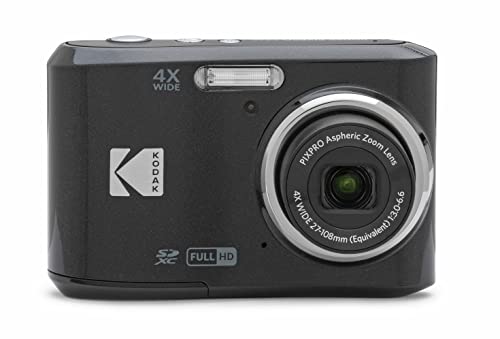The Best Point And Shoot Cameras

To help you find the perfect point and shoot camera, we continuously put forth the effort to update and expand our list of recommendable point and shoot cameras. Our team collects, edits and publishes new information, in order to present it to you in an accurate, significant and neatly arranged way.
Our Picks
6 More Point And Shoot Camera Alternatives
Table of Contents
Buying Guide
Point-and-Shoot Cameras Buying Guide
Are you tired of struggling to take lifelike, vivid photos with your smartphone's mediocre camera? Although smartphone cameras have greatly increased in quality, they continue to lag behind standalone digital cameras because their lenses and image sensors are very small in comparison. The good news is that you don't need to be a professional photographer -- and you don't need to spend a bundle of money -- to upgrade your photography experience dramatically. Smartphones have driven down the cost of point-and-shoot cameras, and a great camera now costs a fraction of what it would have several years ago. Point-and-shoot cameras are also ideal for amateur photographers because they're so easy to use.
There's never been a better time than now to buy a new point-and-shoot camera. This buying guide will help you sift through the features that are available and choose the camera that best fits your needs.
Image Sensor Resolution and Quality
A point-and-shoot camera contains an electronic sensor that captures the image from the lens and saves it as a digital file. A camera manufacturer uses megapixels -- or millions of pixels -- to express the resolution of an image sensor. An image sensor with a higher megapixel rating captures images in greater detail -- but that doesn't tell the whole story. Some image sensors handle lens distortion better than others. Some do a better job of capturing images in low light without artifacts. Some reproduce color more accurately. Before you buy any point-and-shoot camera, it's wise to look for images that others have captured with that camera. Real world performance can tell you a great deal more than a megapixel rating.
Optical vs. Digital Zoom
You'll occasionally want to use your point-and-shoot camera to take pictures of faraway objects -- and for that, you'll need a zoom function. A digital camera has two types of zoom functions: optical and digital.
Optical zoom works with magnification alone. When you zoom, the camera moves lenses apart to magnify the image. Optical zoom allows a camera to focus on a faraway object without degrading image quality. For optical zoom to work, though, the lenses need room to telescope. That's why the smallest point-and-shoot cameras tend to have relatively low optical zoom power.
To augment optical zoom -- or occasionally replace it -- most point-and-shoot cameras also offer digital zoom. A digital zoom works by multiplying the pixels in a digital image. Digital zoom makes an image larger, but it doesn't increase the detail. At low-power settings, digital zoom can create the illusion of a more detailed image. At high-power settings, though, digital zoom results in a heavily pixelated image.
Video Recording
Most point-and-shoot cameras have the ability to record videos -- but not every camera can record high-definition footage even though the resolution of a 1080p video is only about 2 megapixels. The Sony Cyber-shot DSC-RX100 V -- our pick for the best point-and-shoot camera in any price range at the time of writing -- captures 4K video.
Size and Weight
In general, a larger digital camera houses a larger image sensor. Large image sensors capture greater detail without artifacts, reproduce colors more accurately and work better in low light. A larger camera also typically has a more powerful optical zoom because it has room for a long telescoping lens. Because larger cameras have room for more expensive lenses and better electronics, they tend to cost more than pocket cameras. They're also heavier and more difficult to carry.
Aside from the smallest cameras -- which tend to carry premium prices because they're fashionable -- pocket cameras generally cost less than larger point-and-shoot cameras because their lenses and electronic components are less expensive to manufacture. A pocket camera generally produces an image that's better than that of a smartphone camera -- but not quite as good as that of a larger point-and-shoot camera. Pocket cameras also benefit from being extremely light and easy to carry.
Ultimately, the best point-and-shoot camera for your needs is the one you'll actually use. If you'll rarely use a larger camera because carrying it feels like an undue burden, you should buy a pocket camera instead. Having your camera always available when you want to snap a photo will make up for the slight reduction in image quality.
Wireless Connectivity
It is increasingly common for point-and-shoot cameras to include wireless connectivity options such as Wi-Fi, Bluetooth and near-field communication. Wireless connectivity eliminates the need to use a card reader or USB cable to transfer images from the camera. Depending on the camera's software support, wireless connectivity can even allow you to transfer photos to your smartphone or tablet rather than a computer.
Rear Display
A digital camera usually has a rear display that allows you to frame your shots and review your pictures before transferring them to another device. Look for a camera with a display that's bright enough to see in full sunlight. Some cameras also have touch-sensitive screens that allow you to navigate easily through menus.Battery Life and Management
Powering a screen, flash, image sensor and shutter requires significant battery power. Although a point-and-shoot camera can typically take hundreds of pictures with a fully charged battery, even that may not be enough for a full day of shooting. It's wise to look for a camera with excellent battery life, but you should also look for a camera with a battery that you can charge in an external charger. If you can only charge a battery via the camera's USB port, you can't keep a spare battery handy.
Image Processing
Most digital cameras have the ability to apply effects to an image after capturing it. For example, a camera may eliminate red pupils. It may also detect and brighten teeth and eye whites. Cameras may apply color filters to enhance specific types of scenes. Some cameras may even include novelty effects such as the ability to simulate a picture taken with a fisheye lens. You may enjoy a camera with plenty of built-in image processing features if you prefer not to use a computer application such as Photoshop to process your photos.
Raw Image Support
If you want to have the greatest possible flexibility for editing and retouching the photos from your point-and-shoot camera on your computer, you need a camera capable of saving photos as raw image files. A raw image is something like a negative in film photography. It contains the raw data captured by the camera's image sensor with no processing. You'll use a computer application such as Adobe Lightroom or Apple Photos to edit and process the raw file before saving it in a standard image format such as JPG.
Image Stabilization
Holding a camera completely still while framing your shot and pushing the button is extremely difficult. Image stabilization uses a gyroscope to prevent movement from causing a blurred image. Depending on the stabilization technique used, the gyroscope may be in the camera's lens or image sensor. You should always look for a camera that offers image stabilization. Otherwise, you'll find it difficult to capture clear images without a tripod.
External Flash Support
Most point-and-shoot cameras have built-in flashes to provide fill light for bright scenes and improve the quality of images taken in low light. A built-in flash doesn't provide a lot of illumination, though. It may also cause red eye. A more expensive point-and-shoot camera may include a hot shoe -- a metal bracket at the top of the camera -- for attaching an external flash. An external flash provides much more illumination than a built-in flash. You can also use an external flash to illuminate your subject indirectly by bouncing the light off of a nearby surface.
Top Rated Point And Shoot Cameras
If you're looking into finding the best rated point and shoot camera, you should probable check out the Kodak PIXPRO FZ55-RD 16MP Digital Camera. We looked at various sources of reviews and found this one to have the best mix between review count and average rating stars.
The Lowest Price We Could Find
Often, going for the best price is a simple but good option. With a price of $79.99 (last checked this morning), we do not list any other point and shoot camera cheaper than the VJIANGER 4K Digital Camera. Just remember that it's not always the best option to go for the cheapest one.
The Point And Shoot Camera With the Most Reviews
With at least 0 reviews and counting, the Kodak PIXPRO FZ55-RD 16MP Digital Camera might be another option to consider. This large amount of reviews signalizes that many people are using it, with most of them beeing satisfied.
High Quality Point And Shoot Cameras
It's quite rare that the saying "You get what you pay for" turns out incorrect. If you have the money on the sideline, feel free to choose the most expensive item from our list: The Panasonic LUMIX ZS99 and Camera currently sells for $697.99.
The Point And Shoot Camera With the Most Clicks
If you trust us and our users, feel free to check out the Kodak PIXPRO FZ55-RD 16MP Digital Camera. Our statistics say that it is the most favorite Point And Shoot Camera from the list above.
Our Bestseller
If you're still undecided, I would recommend that you go with the masses and choose the top selling point and shoot camera: The KODAK PIXPRO Friendly Zoom FZ45-BK 16MP Digital Camera is the hottest bestseller in this category right now.
Point And Shoot Camera Reviews
Further Reading on Point And Shoot Cameras
Research
Wikipedia Article for Point And Shoot Camera
Olympus Recalls Digital Point-And-Shoot Camera Due to Shock...of Camera ...of Camera ...
Digital Point-And-Shoot Camera Due to Shock Hazard; Sold Exclusively at HHGregg Appliance...of Camera ...of Camera ...
Olympus Recalls Digital Point-And-Shoot Camera Due to Shock Hazard; Sold Exclusively...of Camera ...of Camera ...
Camera Due to Shock Hazard; Sold Exclusively at HHGregg Appliance...of Camera ...of Camera ...
Point-And-Shoot Camera Due to Shock Hazard; Sold Exclusively at HHGregg Appliance...corner of the front of the camera. The camera has a 3 inch digital LCD screen on the back....Consumers should immediately stop using the recalled digital camera and contact Olympus...
… Su Cheng UniversityofNotre Dame NIST Abstract Inexpensive “ point -and- shoot ” camera technology has combined with social network technology to give the gen- eral population a motivation to use face recognition tech- nology …
Fujifilm plans to halve its product line—down from 20 models last year, limiting the number of less expensive devices while introducing more premium cameras. Panasonic said it plans to reduce the number of" entrylevel" models with a goal of slashing fixed costs at the camera …
… The present invention uses a point -and- shoot camera paradigm for instant familiarity and ease of use … 3. Apparatus according to claim 1. with a common look and feel, using a common point -and- shoot camera paradigm for instant familiarity and ease of use …
Comments
About this Article
It was last updated on 2025-12-17 08:07:27 and has been viewed 6978 times.



